AI in Finance uses intelligent systems to manage financial tasks with speed and accuracy. These systems include machine learning, deep learning and natural language processing.
They analyze structured and unstructured data, detect hidden patterns and generate predictions.
By applying artificial intelligence in finance, banks and fintech firms improve decision-making, reduce fraud risks and personalize customer services.
They rely on these tools for risk scoring, portfolio modeling, chatbots and compliance checks.
Global adoption confirms the shift. In 2024, the financial sector spent 45.19 billion USD on AI, according to Statista. The European banking sector accounted for 15.7 percent of that investment or 7.24 billion USD. These numbers show that AI for finance is now central to strategies across banking, insurance and investment.
The growing role of AI leads to an important question. Why do financial services need AI today more than ever?
Finance runs on trust, accuracy and speed. Traditional processes struggle with growing data volumes. Manual work slows decision-making and creates room for errors. In a digital economy, this risk is too high.
AI in Finance fills the gap by processing massive datasets without delay.
Customer demand also drives adoption. People expect instant support, personalized advice and secure services. Banks and insurers must meet these expectations while following strict regulations.
AI for finance helps by reducing workloads and creating faster, smarter interactions.
Market trends confirm this urgency. AI adoption in insurance underwriting has reached 44 percent, improving how firms assess and price risk. Generative AI is spreading fast too, with 52 percent of financial services providers already adopting it.
These trends show why firms see AI not as an experiment but as a requirement.
The benefits of AI in finance explain this rapid adoption. They highlight how AI improves outcomes for both institutions and customers.
AI in Finance brings direct value to firms and customers. Each advantage answers a challenge that financial services face daily. Together, they explain why adoption keeps rising.
Financial markets move fast and decisions lose value if delayed. AI models read data in real time. They expose patterns, signal risks and guide immediate actions.
Firms use machine learning in finance to predict credit outcomes, adjust portfolios and spot trends. This speed creates stronger strategies and sharper confidence.
Slow manual tasks create pressure on finance teams. AI for finance automates reconciliation, payroll and reporting. Automation lowers costs, reduces mistakes and frees experts to focus on client needs. By cutting waste, firms gain more space for strategic work.
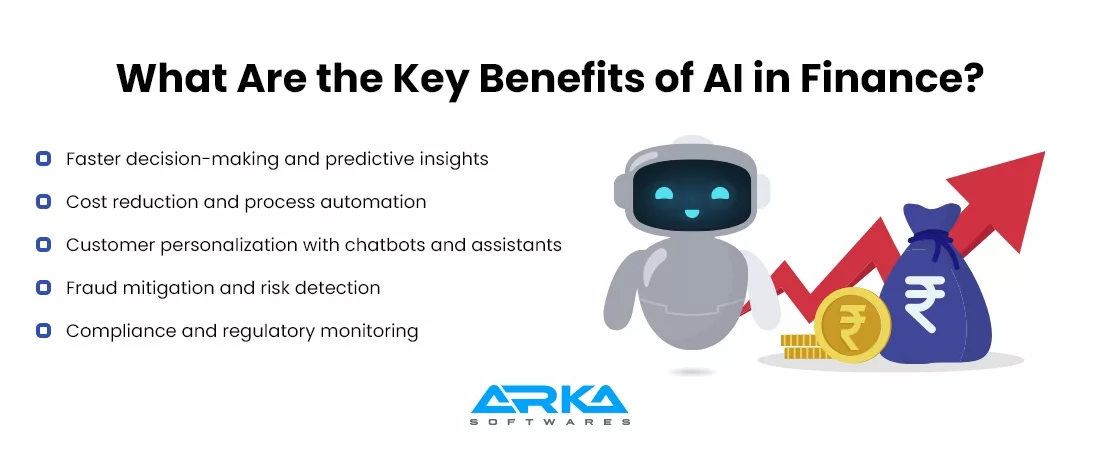
Clients now expect quick and tailored service. Finance AI chatbots deliver support around the clock. They answer queries, track payments and recommend products that match personal goals.
Virtual assistants improve customer experience and build stronger loyalty.
Fraud remains a major threat in finance. AI systems track transactions and detect unusual patterns before damage occurs. Predictive models reduce false alerts while increasing accuracy.
Mastercard already applies AI in risk and compliance to strengthen fraud defenses and protect customers worldwide.
Regulation grows more complex each year. Artificial intelligence in finance helps firms stay compliant by scanning transactions, detecting anomalies and preparing audit-ready reports.
These systems reduce errors and maintain trust with regulators and clients.
Each benefit proves why AI has moved from an experiment to a core strategy.
With value clear at every level, the focus now shifts to the most common applications that define how AI shapes finance today.
The benefits of AI in Finance become clear through real applications. These use cases show how firms apply AI across risk, customer service, investments and lending.
Each one connects directly to the next, creating a complete picture of AI adoption.
Fraud is a constant threat in financial services. AI models scan transactions in real time to detect suspicious activity. They use anomaly detection and predictive modeling to flag irregular patterns. AI in risk and compliance reduces false alerts and speeds up investigations.
Global players prove this in practice. Mastercard applies AI to monitor payments worldwide.
The system prevents fraud at scale and strengthens trust between banks and customers. Fraud detection links directly to customer service, where AI also plays an important role.
Firms use finance AI chatbots to deliver fast, personalized service. Virtual assistants answer account questions, guide transfers and provide tailored advice. They operate around the clock, improving both access and convenience.
Bank of America’s Erica is a clear case.
It has managed billions of interactions, supporting clients without delays. Chatbots connect naturally to the next area of adoption: investments and financial modeling.
Markets move quickly and investors demand precise insights. Machine learning in finance supports predictive analytics by studying market trends and historical data.
Firms apply AI financial modeling to forecast performance and rebalance portfolios.
This use improves both speed and accuracy in investment decisions. It links directly to credit scoring and loan approvals, where AI creates fairer access to finance.
Traditional credit scoring relies on limited data, often leaving many people excluded. AI loan company models expand access by using alternative data, such as payment history and digital behavior.
This approach speeds up loan approvals and reduces bias.
The shift to AI-driven credit processes shows how adoption reaches every area of finance. With these applications in place, the focus now turns to the next wave of innovation: Generative AI.
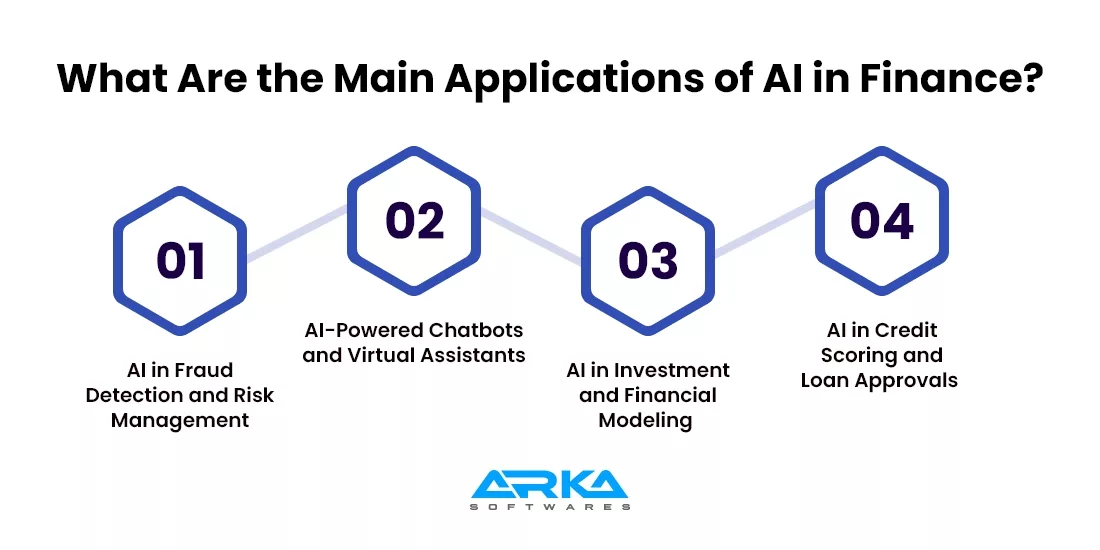
The main applications of AI set the foundation. The next step is Generative AI in Finance, which introduces new tools and deeper automation. Unlike predictive models, Generative AI creates content, insights and simulations that support both firms and clients.
Generative AI supports banks with customer queries, compliance documents and market reports. In Generative AI in Banking, systems can draft personalized advice, summarize regulations and prepare client-ready updates.
These features extend the role of chatbots and connect back to the service improvements noted earlier.
Specialized tools make adoption practical. Finance GPT focuses on financial analysis and research. Bloomberg GPT supports traders and analysts with news summaries and sentiment analysis.
IndexGPT, created by JPMorgan, aims to guide retail investors by suggesting funds and securities. Each tool shows how Generative AI moves from research labs to active finance workflows.
One clear example is synthetic data generation. Firms face limits in using real client data because of privacy rules. Generative AI creates realistic but anonymous datasets.
These datasets train fraud detection models and support stress testing without breaking compliance. This ties back to fraud monitoring and compliance, two of the top use cases in finance.
Beyond synthetic data, Generative AI helps prepare compliance reports, summarize risk filings and create fraud simulations. These capabilities save time and reduce manual workloads.
They also link directly to regulatory monitoring, which remains a top priority for financial firms.
The demand for specialized tools is growing. Teams search for the best finance GPT models that combine domain knowledge with speed and accuracy.
These models provide quick insights for analysts, compliance officers and advisors.
Generative AI offers powerful opportunities, but it also raises questions about trust. This leads to the next critical area: explainability.
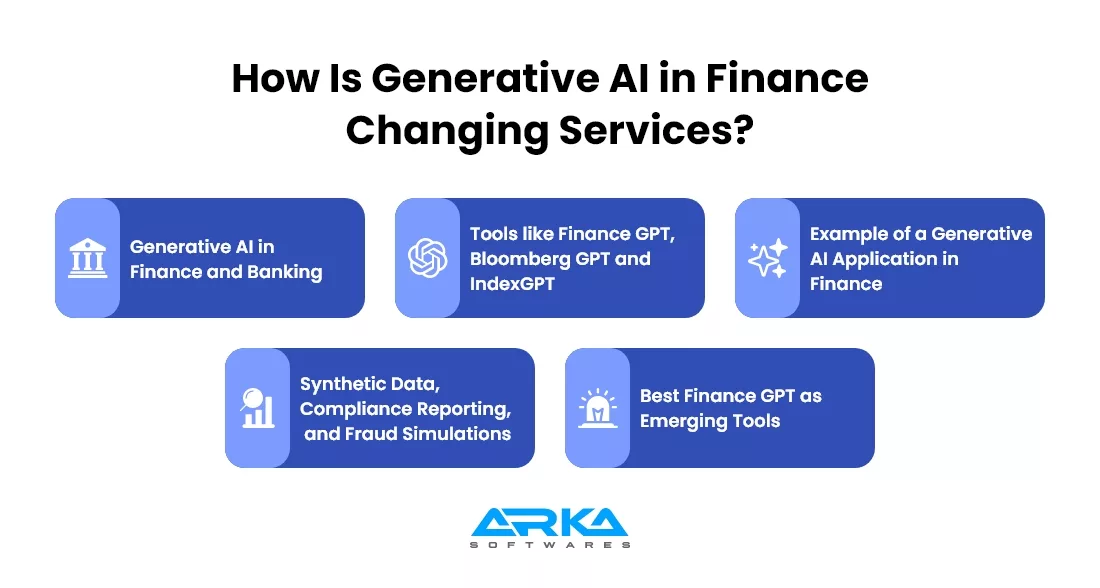
Generative AI expands financial services with new tools, but it also raises questions about trust. Firms need clear answers about how models reach their conclusions. This makes explainable AI in finance a priority.
Traditional models often work as “black boxes.” They give results but do not reveal how they were calculated. In finance, this is not acceptable.
Clients need to know why a loan was approved. Regulators need to confirm that credit scoring is fair. Investors want to see the factors behind a portfolio decision.
Machine learning in finance supports predictive accuracy, but without transparency, firms face risks. Explainable
AI provides clarity. It highlights the features that influenced a decision, offers reason codes and creates audit trails. This improves both fairness and accountability.
Regulators are also demanding this shift. The EU AI Act sets strict requirements for high-risk financial models. In the United States, guidance from agencies highlights the need for explainability in credit scoring and risk analysis.
Singapore’s MAS guidelines emphasize fairness and human oversight. Together, these frameworks show that compliance now depends on transparent AI.
Trust in AI does not end with explainability. Firms also need proof that AI delivers value in the real world. The next section looks at practical examples where AI already drives impact across finance.
Explainable AI shows why transparency matters, but proof comes from real-world adoption. Leading firms use AI in Finance across banking, investment and insurance. Each example highlights a different use case.
JPMorgan built the COIN platform to analyze legal contracts. It reviews thousands of pages in seconds, a task that once required hours of human effort. This system reduces errors and frees legal teams to focus on strategy.
Bank of America launched Erica as a finance AI chatbot. Erica answers balance queries, tracks payments and provides alerts. With billions of interactions handled, it shows how virtual assistants improve service at scale.
Mastercard applies AI in risk and compliance to monitor transactions worldwide. Its systems detect suspicious activity in real time, reducing fraud losses and protecting customer trust. This example links back to the earlier benefits of fraud detection.
Firms like Betterment and Wealthfront use machine learning in finance to provide investment guidance. Their platforms build personalized portfolios, adjust them to market changes and support long-term financial planning.
Smaller players also drive innovation. Fintech startups apply AI to credit scoring, loan approvals and wealth management. These fintech examples show that adoption is not limited to large institutions.
These cases confirm that AI is already central to financial services. Still, challenges remain. The next section addresses the risks that firms must manage as they expand AI adoption.
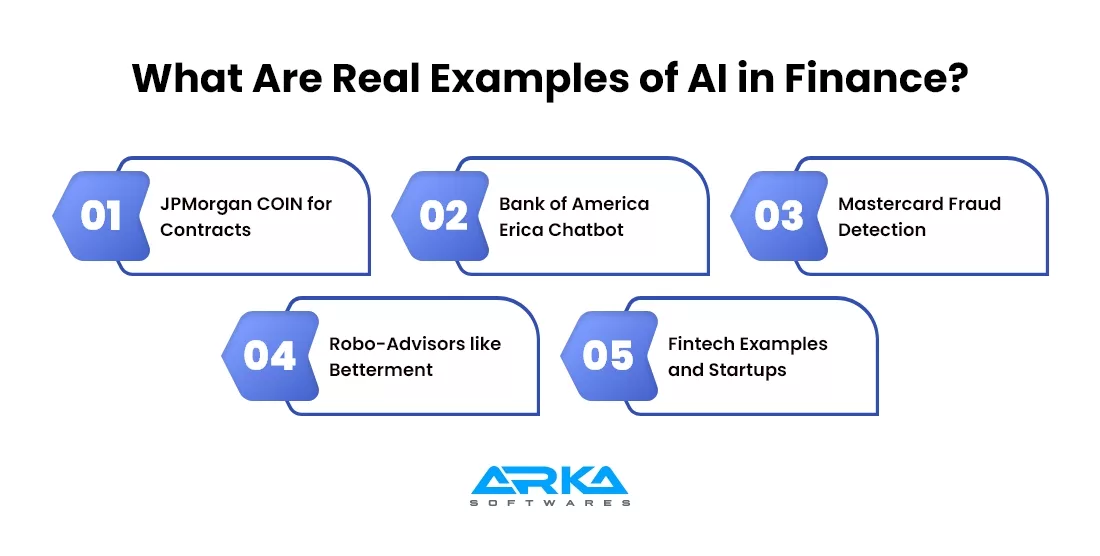
The success stories of AI adoption prove its value, but they also expose key risks. Financial services cannot ignore these challenges, as they directly affect trust and compliance.
AI models learn from historical data. If that data carries bias, the outputs reflect it. This creates unfair results in credit scoring and lending. Firms must monitor models carefully to avoid discrimination and ensure equal access.
AI systems handle sensitive financial data. Weak points create opportunities for attacks.
Data leaks or manipulation of models threaten both institutions and customers. Strong safeguards are required to protect systems.
Banks face constant threats from cybercrime. Attackers target both customer accounts and internal systems.
Cybersecurity for financial institutions must include AI-based monitoring, encryption and layered defenses to keep pace with new threats.
Effective AI depends on clean and complete data. Many firms still struggle with data locked in silos.
Poor governance reduces model accuracy and limits the impact of artificial intelligence in finance. Investment in data integration is critical for long-term success.
Large AI models demand significant resources. Training and maintaining them requires both computing power and skilled staff. For smaller firms, costs remain a major barrier.
This slows adoption and increases reliance on third-party providers.
These challenges explain why firms must balance ambition with caution. With risks clear, the next question becomes: how will AI shape the future of financial services?
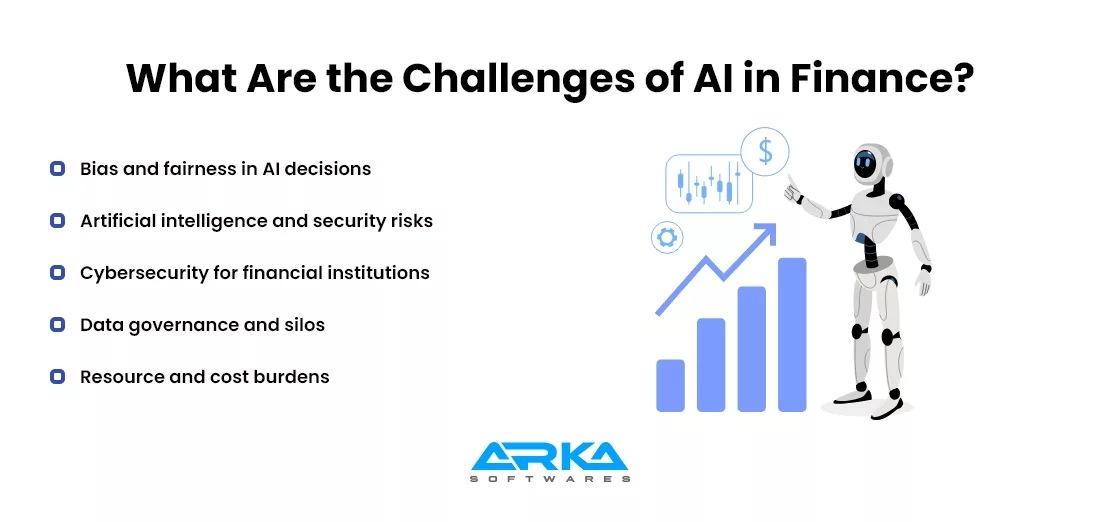
The challenges of adoption highlight the need for balance. Firms must control risks while continuing to expand. The future of AI in Finance depends on smarter tools, new models and stronger governance.
Global spending on AI in finance continues to rise. Statista reports that adoption of Generative AI in financial services has already reached 52 percent.
This trend shows that advanced models are moving from pilot use to daily operations. Firms will focus on tools that create value at scale without increasing risk.
The next stage involves systems that act with greater autonomy. Agentic AI can complete workflows, such as processing a loan or preparing a compliance report, without full human input.
RAG improves accuracy by combining large language models with verified data sources. Both advances promise higher reliability.
Complex financial models often push current computing limits. Quantum computing can solve optimization problems that traditional systems cannot handle.
In the future, quantum algorithms will support risk modeling, portfolio optimization and advanced forecasting.
Services are becoming more integrated into daily life. Personal finance AI tools already provide budgeting advice and savings plans. Embedded finance extends this by offering credit, payments and investments inside non-financial platforms.
AI will guide these services with personalization built into every interaction.
Sustainability is also shaping future priorities. Firms will use AI to track environmental, social and governance (ESG) metrics. These tools will help assess climate risk, manage green investments and report on sustainability goals.
AI will not replace people but change their roles. Finance teams will focus on oversight, strategy and client relationships, while AI handles repetitive tasks. Collaboration ensures speed, fairness and trust.
AI in Finance has moved from pilot projects to a core strategy. Firms invest billions to improve accuracy, reduce risks and create better customer experiences.
Generative AI adds new opportunities, from synthetic data to compliance reporting. At the same time, it introduces risks that require oversight. Explainable AI in finance is no longer optional. Transparency builds trust with both customers and regulators.
The future points toward agentic AI, quantum computing and hyper-personalized services.
ESG-focused adoption will also grow as firms track sustainability goals. Human-AI collaboration will define success by combining speed with accountability.
Financial services that adopt AI with care will deliver smarter, faster and safer solutions. Those that ignore it risk falling behind in a market where trust, accuracy and speed matter most.
AI in Finance supports fraud detection, credit scoring, portfolio analysis and customer support. Banks also apply AI to compliance monitoring and risk assessment. These uses improve accuracy and save time.
Banks use finance AI chatbots, predictive credit models and fraud detection tools. Virtual assistants such as Erica from Bank of America show how AI improves service at scale.
AI systems scan transactions in real time. They use anomaly detection to flag unusual patterns. AI in risk and compliance reduces false alerts and improves fraud prevention.
Yes. Machine learning in finance forecasts market movements and analyzes risks. Investors use these insights to adjust portfolios and make informed decisions.
Yes. Machine learning in finance forecasts market movements and analyzes risks. Investors use these insights to adjust portfolios and make informed decisions.
Yes. Machine learning in finance forecasts market movements and analyzes risks. Investors use these insights to adjust portfolios and make informed decisions.
Finance AI chatbots answer customer queries, track payments and suggest products. They provide 24/7 support and reduce pressure on call centers.
AI is safe if firms apply strong safeguards. Artificial intelligence and security measures include encryption, monitoring and layered defenses. These steps protect customer information.
AI faces challenges such as bias, high costs and data silos. Models also require skilled oversight. Without proper controls, results may lack fairness or accuracy.